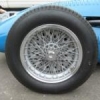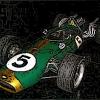Normal aero cars will always suffer in the corners when close to another car.
But i have great trust in Ross Brown,...
The possible solutions change the trailing car's downforce level to make up for the loss in the wake. What should be tested? Wing blowing and/or suction with the help of a standardized mandatory system, ...
Ross Brown, thanks for your future work!
Firstly, I have no faith in Ross Brawn ... (you had a typo by the way). He's clever etc etc but the number of players makes genuine reform tougher and tougher. For instance - Mercedes have got their way, mostly IMO due to Toyota, Honda, BMW etc leaving. The big players always threaten to leave, and they protect what they perceive as their various competitive advantages. For instance, spending is one of those ...
But your point on suction ... putting in an electrically driven fan on the front of the car, would re-establish front grip in the corners. Its use would also retract from straight line electrical power, so there would be some "give and take" over its use. And hey - its a "green thing"  . It would solve everything .... OK ... let Ross decide on Race Day the duration of the fan ... maybe it wouldn't work unless a car was close in front ... or another way, if a car started to loose downforce in the front, then it could work ... (no point running it at low speeds anyway because it would waste batteries).
. It would solve everything .... OK ... let Ross decide on Race Day the duration of the fan ... maybe it wouldn't work unless a car was close in front ... or another way, if a car started to loose downforce in the front, then it could work ... (no point running it at low speeds anyway because it would waste batteries).
I always go back when discussing this issue, to Montoya, who commented: If you want overtaking, simply make all the downforce produced in-between the front and rear wheels. The air from that downforce would be evacuated over the rear tyre, and hence would not effect the rearward car ...
I guess, one would extract the air from low in the front and exhaust it in between the front and rear tyre ... and make the downforce occur in between the front and rear tyre.
Edited by Melbourne Park, 07 March 2017 - 02:53.































